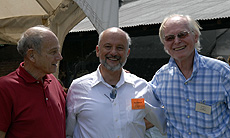Pierre Auger Inauguration

From left: Jim Cronin, Pier Oddone and Alan Watson
Last Friday, the official ceremony to inaugurate the Pierre Auger Observatory took place in Malargüe, Argentina. The Argentine vice president, the governor of the province of Mendoza and many dignitaries from the countries contributing to this great observatory were present. A symposium on the construction of the observatory and the physics results and future prospects preceded the ceremony. The following day, a caravan of mini-buses left from Malargüe to tour the observatory. It was an awesome experience.
The audacity of the folks who conceived the observatory to cover 3,000 square kilometers of the Argentine pampa with detectors is evident in the amazingly vast landscape of the Pampa Amarilla, the basin where 1,600 Cerenkov counters are placed on a regular grid against the backdrop of the Andes. These counters detect the extensive cosmic-ray showers that originate with primary particles that have energies up to a hundred million times the energy of the Tevatron beam and strike a nucleus high in the atmosphere.
In addition to the Cerenkov counters that are arrayed in the basin, 24 fluorescent telescopes record the light produced by these massive showers in the atmosphere from promontories in the periphery of the array. Even before its completion and inauguration the Pierre Auger Observatory already produced important and surprising results.
Professor Jim Cronin of the University of Chicago and Professor Alan Watson of Leeds University were the pioneers of this experiment, starting with a challenge from Cronin in 1991 to think big: a 5,000 square kilometer array. In 1995, a six-month-long workshop at Fermilab led to the design of the observatory.
Since selecting the site in Argentina the collaboration has grown to be very broad, with 17 countries, 71 institutions and more than 400 scientists collaborating in the enterprise. No single country is dominant, but Fermilab's role in the engineering and management of the project was much complimented at the inauguration, especially the leadership of Paul Mantsch as project manager and the contributions of the very strong Fermilab team on the project.
There are many notable qualities of the Pierre Auger collaboration and its impact on the community of Malargüe, a town where physicists are rock stars. Politicians take pride in the observatory and have used it to promote Malargüe as a destination for science tourism. A modern conference center, a planetarium and improved schools are all a result of the adoption of physics by political representatives and the local population. The then-mayor of Malargüe, who supported Pierre Auger, is now the governor of Mendoza province after being a senator for Mendoza in Buenos Aires - a meteoric career propelled by cosmic air showers.
As we left Malargüe Sunday morning to return to the U.S., the physicists and staff of Pierre Auger were getting ready to take part in the annual parade celebrating the founding of Malargüe as an independent town. Traditionally, the loudest cheers along the parade are for the Pierre Auger team.
|